Of saddle fit, shoulder blades, and "flare"
We are no longer building saddle trees, but we have two videos about how Western saddles fit horses available on our westernsaddlefit.com website.
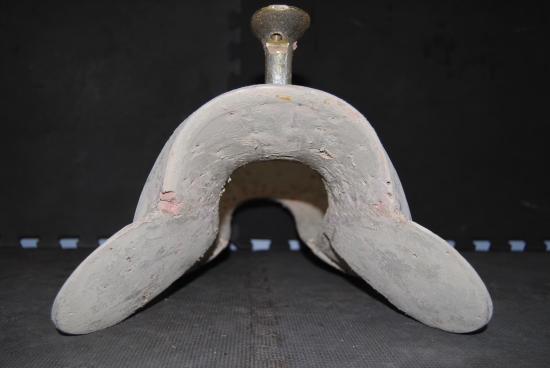
Something we read about quite often when looking at information on saddle fit is that the tree should “flare” out at the shoulders so there is room for the shoulder blade to rotate back as the horse moves. The idea is that the tree is not contacting the horse at all for a distance behind the front bar tip. Depending on the person teaching, that distance can be an inch or two all the way up to five or six inches. While this idea may sound good, practically it has major problems. Allow me to demonstrate with a tree we have here that we duplicated.
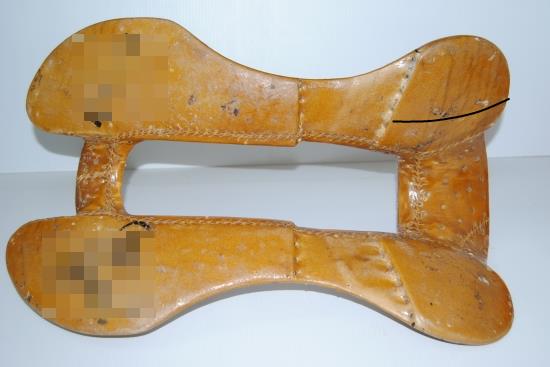
There are a number of different definitions of “flare”, including using it as a term for the measurement across the bottom of the bars, which is why we don’t like using the word at all in describing tree shape. However, in this post I will be using it by the dictionary definition of “curving outwards”. Where the “flare” starts and how dramatic it is all varies with the maker. As you can see in this picture, the front of the bars really angle outward, starting pretty much at the stirrup groove and going forward from there, so the whole front bar pad is angled out. What this is really doing is dramatically increasing the rock ahead of the stirrup groove.
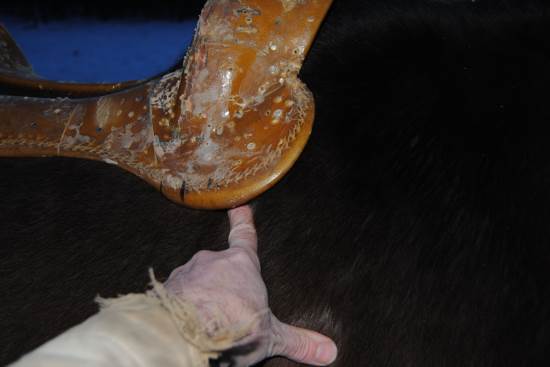
Here is that tree on a pretty broad withered horse - D7 at the A position for those familiar with the Dennis Lane system. Even on this horse, Rod could put his forefinger under the front bar up to the second knuckle before there was any contact at all between horse and tree.
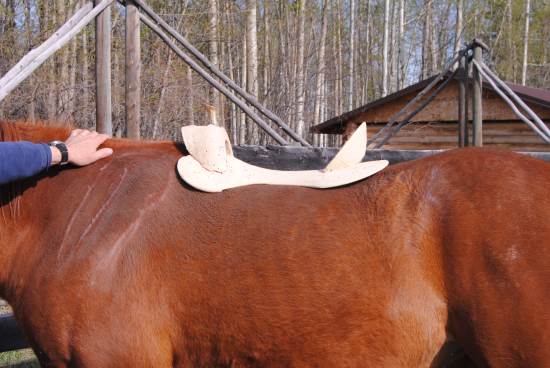
We have experimented with this tree a couple of times. Here, we put it on our Dancer horse in the proper position for a Western tree - with the bar tip right behind the shoulder blade.
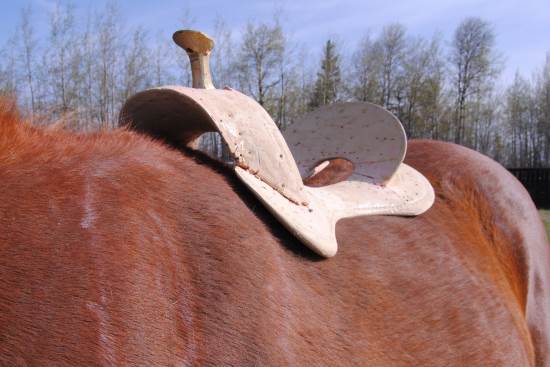
When you look at it from the front, you can see how much it flares away from her shoulders. So it sure looks like there is lots of room there for shoulder blade movement, and that has to be good - right? Well, maybe not so much… (We’ve discussed before why this isn’t necessary and the anatomy behind that, and later the pressure mat evidence that shows why this is correct.)
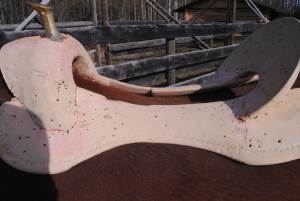 |
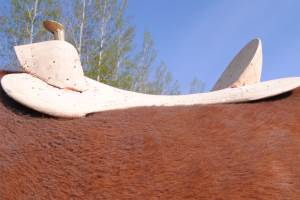 |
The angle of the bars look like they match this horse pretty well, not just at the front but also along the length of the bar. Remember, of course, that when you evaluate tree fit you gotta look inside… (If anything, the center of the bar could have a bit more angle on it, though in this case it is mild enough it won’t hurt this horse because she isn't really wide backed.)
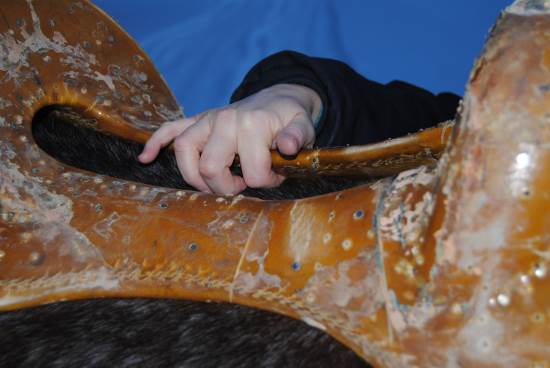
On the wider backed horse, the inside edge of the bar was off the horse by an inch or more, so this tree was not meant to fit a wide backed horse.
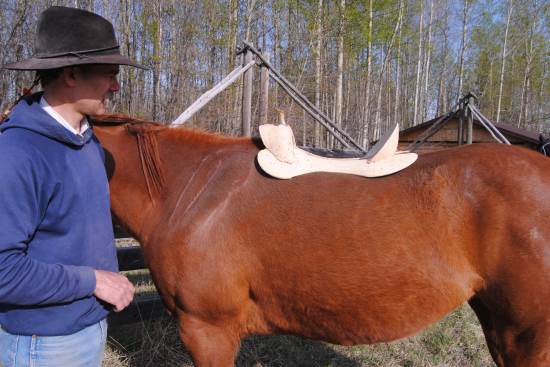
The tree is also not tilted down at the front, which happens if you get a tree that is too wide. It is sitting nicely on her back. So this tree was built to fit a horse of this type, but was built with the idea that the bars should “flare” away at the shoulders. One of those ideas that really does sound good - till you test it in real life situations…
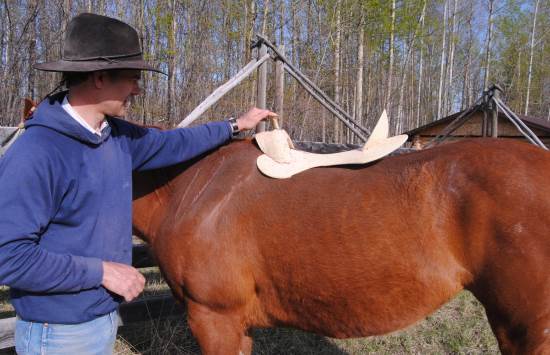
But look what happens if you put any pressure on the front of the saddle. It tips dramatically, rocking forward around a pivot point that looks to be about the stirrup groove area. So when would this happen? Depending on the rigging position, even cinching the saddle up could cause some tipping of the saddle. Definitely if you are roping and the rope is pulling forward. It could also have some of this effect if the rider just stood in their stirrups. And what if you leaned forward to open a gate, ride up a steep hill or duck under a branch? Unless the rider were strictly working on their equitation in an arena or other flat ground, this would happen. And since this was a saddle used by a working cowboy who roped as part of his job, it did happen - a lot!
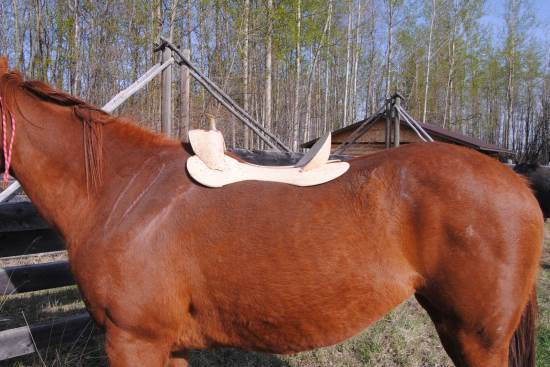
What we also found when placing the tree on the horse, it wasn’t at all stable when the front bar tips were behind the shoulder blade. Remember our cutlery example, where the shapes go to where they match the best, and if they didn’t match, they moved around a lot? Well, this tree moved around a lot - until it got to this position on the horse, and that is where it liked to be. Basically, it was only solid when that “flared” area was actually was in contact with horse.
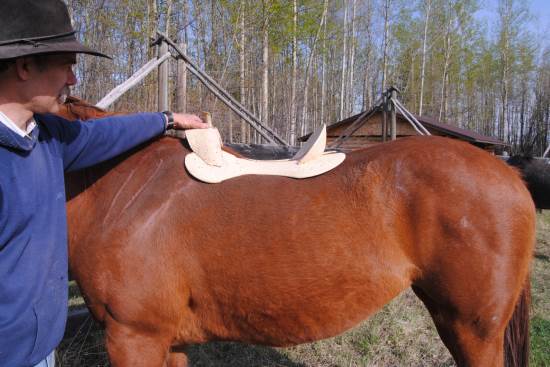
In that position, when there was pressure down on the front of the tree, it didn’t tip or rock. This is where the shapes match the best. And this is where the saddle would move to. But this is also where you will cause problems for your horse. That muscle over his shoulder blade is now being compressed between hard bone and hard bar all the time. So this design actually causes the damage it is trying to avoid.
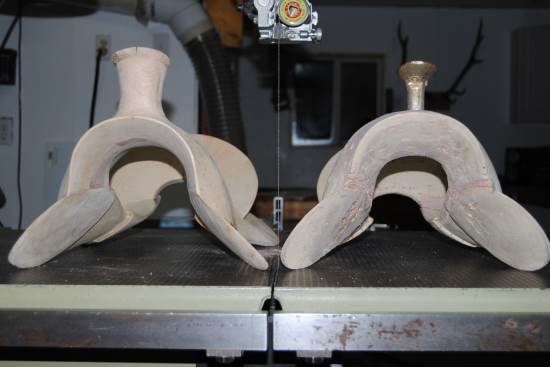
Here is the original tree next to the duplicate we made so they could reuse the the old leather. You can see the difference in how the front bar tips angle outwards between the two trees. We shaped the underside of the bar the way we normally do on the replacement, putting our normal relief (a short section which curves away rapidly so there isn’t a sharp edge) at the front bar tips. Our customer put the saddle back together and his customer was happy with the way it worked after the tree was changed out. Which is a good thing, because if you noticed, that tree wasn’t broken. We were asked to duplicate it because it was soring horses. Sometimes great ideas aren’t really all that great after all…
(You can also easily see a few differences in the fork. It has a much thinner gullet and edge. We discussed this with the saddle maker ahead of time and he was happy to make a new gullet piece for it. This was primarily because of the difference in the horns. The original tree was sold as a “wood post horn” with enough bondo built up around the metal horn to give the extra diameter and look of a real wood post horn. The saddle maker was curious enough about it that he took off the rawhide over the horn and went exploring before he sent the tree to us. So although that horn had a larger neck diameter, the fork had none of the other advantages a wood post horn gives for roping, because it really wasn’t. The replacement was the real deal.)
Addendum: Here's a story that has confirmed what we are saying about flare.
Addendum 2: We have since done some pressure studies that tell us to rethink the popular ideas about saddle fit and shoulder movement, showing the whole idea of "flare" isn't needed at all.
